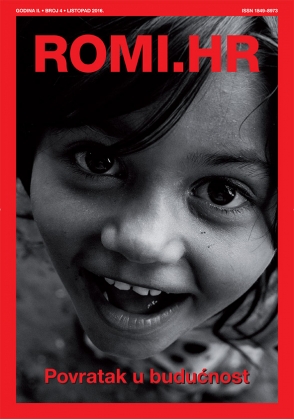News ROMI.HR
/Lyalya Chernaya was a pearl of Roma cultural heritage in the 20th century. The artist had a lot of admirers and followers, Roma people themselves called her their Queen. Why did she gain all these honors and fame?
115 years ago, on February 15, 1909, one of the most prominent pop stars who made a great contribution to the heritage of Roma culture, Lyalya Chernaya, was born.
Honored Artist of that time, artist of the Romen Theater, dancer, and performer of Roma songs and romances, was the pearl of Roma art of the 20th century. Lyalya Chernaya (real name Nadezhda Kiseleva) was born in 1909 in the city of Nalchik in the family of a Russian nobleman and an artist of the well-known Strelnitsky Roma Choir named after Ivan Rom-Lebedev. For her dark skin color, big black eyes with luscious eyelashes, Nadya received the first part of the pseudonym – Chernaya (russ. black). The cuteness and delicate facial features inherent in small children gave the second one - Lyalya (Russ. baby). That's how friends and high-ranking guests who often visited her family's house called her. Under the fictitious name, the entire Soviet Union soon found out about the beauty.
Although she inherited Roma roots only by her mother's side, from the age of 13 Nadezhda Kiseleva danced the “Vengerka” (a dance generally accepted in Roma creative circles) in Moscow restaurants in the evenings after school. Whenever the girl was appearing on stage, the audience froze.
The Roma choir toured throughout the country, at the age of 15 Chernaya became a real star and performed not only in restaurants, but also on the real stage, and participated in annual thematic concerts in the Hall of Columns and the Bolshoi Theater in Moscow. Indicatively, it was Nadezhda Kiseleva who had a great influence on the formation of generally accepted stage dance. In 1931, the young talent became part of the newly opened studio of the Romen Theater. The salary was small, but this fact did not bother Chernaya at all; she wanted to serve art and took on the high mission of educating her people, preserving their culture and national traditions, and widely introducing people of different nationalities to them.
The theater quickly gained universal fame, and Nadezhda Kiseleva became its pearl. In the debut production of “Life on Wheels” she was entrusted with the main role. The play tells a story about the hardship of Roma's transition to a settled life and young people saying goodbye to the past. The performance paved the way for success in a theatrical career; Lyalya Chernaya’s name was highlighted in bold font on all the theater’s posters. The artist devoted her entire life to “Romen”. Over the 52 years of her theatrical activity, she took part in 35 productions, among which were “Carmen from Triana” by I. Rom-Lebedev based on the short story “Carmen” by P. Merimee, “Grushenka” based on the story by N. Leskov “The Enchanted Wanderer”, “Gypsies” based on the works of A. Pushkin, “Bloody Wedding” by G. Lorca, and many others.
Kiseleva’s movie debut happened in 1928; her first cinematography work was a movie called “The Living Corpse,” where she performed the role of a dancer. A few years later, in 1936, the woman appeared on camera again – this time she got a role in the movie “Gypsies”. There, Lyalya sang the song “Wanderer”: “Oh, tell me, tell me, wanderer, where do you belong, where are you from...”. The song became a Roma folk song, and Chernaya became a recognized singer. After this movie, cinema critics dubbed the artist “Romani Lyubov Orlova” (Lyubov Orlova - one of the most outstanding actresses of that time, who received the highest theater and movie awards), and Roma themselves - their Queen.
It is noteworthy that about forty years passed between the second and the third cinema pieces with the participation of the Roma star. In 1976, viewers were glad to see Lyalya Chernaya in one of the most famous movies of the Roma heritage - “Gypsies Are Found Near Heaven”, where she played the role of an old Roma woman. Having played in 8 productions, the theater and movie actress left an indelible mark on the hearts of viewers. Such was the power of the beauty and talent of the black-eyed artist - few could resist her.
Everyone who knew Lyalya personally noted her kind disposition and desire to help everyone in need. During the Second World War (1939-1945), Chernaya with the Romen Theater regularly went on tour to military units and hospitals. Theater performances supported the fighting spirit of the soldiers and gave positivity in the most terrible and dark times. Moreover, during Stalin's repressions, the woman, without any fear, regularly sent parcels to the North to her pals and friends. Her acquaintances noted more than once that she could take off her last coat or give jewelry on the street to a poorly dressed woman with a child.
Nadezhda Kiseleva remained faithful to the stage until the very end. At one of her last performances in 1982 she felt sick, the artist was taken to the hospital, where, unfortunately, she passed away. At that time, the talented actress was 73 years old. Chernaya's true talent went down in history, and her name became synonymous with Roma's authentical art, which at the dawn of her life she willingly shared with the younger generation of artists. Although theater and movie productions with their colorful costumes, romanticized lifestyle, and positivity are very different from the real life of Roma, they formed an important cultural layer in the history of Roma and reflected traditional folklore. Lyalya Chernaya was like one of the brightest stars that lights up very rarely.


.jpg)











